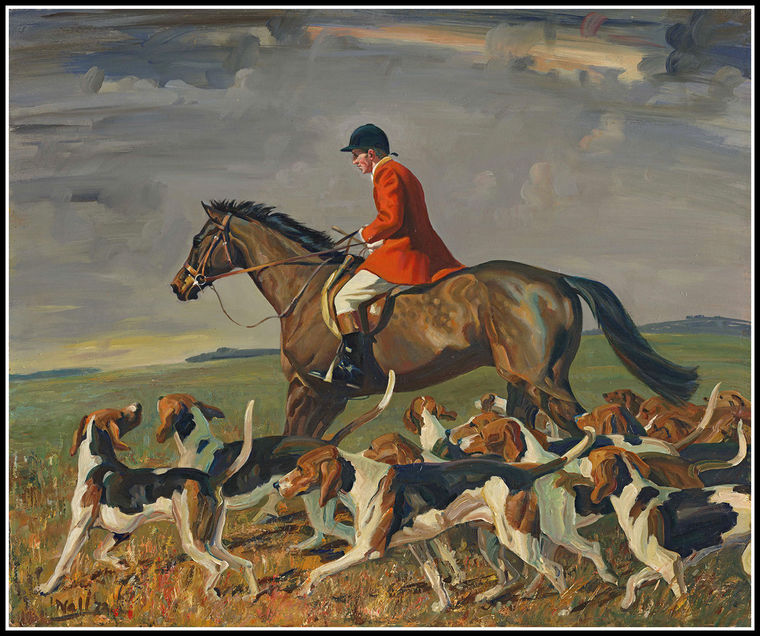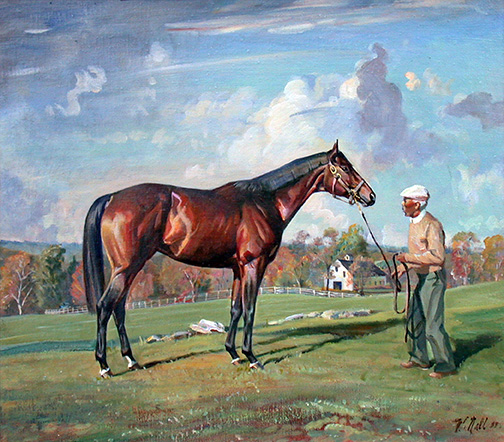An afternoon trip to the Morven Park Museum of Hounds and Hunting in historic Leesburg, Virginia stepped us through the region’s rich history in fox hunting and beyond. The experience reminded me of many scenes and parallel events in House Key, particularly the impact of the Civil War on the Piedmont area. The Morven Manor house, a massive Greek Revival structure that evolved from a 1780 fieldstone farmhouse, has the Catoctin Ridge for a backdrop, so reminiscent of the MacRae’s Wildcat Mountain and Greigston Manor. Also expanded through the generations, Morven Manor was extensively remodeled in the twentieth century. We were there to see the Wallace Wilson Nall, III painting exhibit of horses and hounds, a display of about 50 images. The exhibit spanned two rooms in the Morven mansion and several decades of paintings, most on loan from private collections in the area.
Nall was prolific and popular with the local hunt clubs, whose masters of fox hounds are often depicted with remarkable likeness, according to my friend and Whipper-in who had met many of them as a youngster. It was as much fun studying the paintings as it was observing her reactions as she exclaimed, “That’s So-and-so, and that’s just how I remember his expression!” Then she’d reminisce about their feats and their horses, many of whom she remembered, as well.
MiddleBurg Life magazine describes Nall as a California native, a World War II veteran of the Army First Calvary (Texas) and a lifelong horseman. His true gift emerged when he moved to Middleburg in the 1970’s and executed a large body of commissioned work until he passed away at 81 in 2003. Valued for his ability to capture the elegance and gentility of equestrian sport through the gesture and expression of its subjects, his work was featured several times on the covers of Chronicle of the Horse throughout the years. One portrait, in particular, of Harcourt Lees, a former Warrenton Hunt Club MFH, depict horse and master sharing the same benevolently thoughtful gaze toward something just over the viewer’s shoulder. It captures that sense of peaceful partnership, mutual understanding and harmony we all strive to achieve with our horses. To this end, Nall’s scenes depict the Piedmont’s recognizable countryside as idyllic backdrops, sometimes merely suggested with the abandon of broad strokes in sharp contrast to the detailed precision that highlights the subjects. Nall’s smaller portraits of hounds are active and playful, but each one reflects the distinct personality of the hound, something easy to overlook in a swirling pack of black and brown spots and wagging tails.
A separate Hall of Fame room adjacent to the exhibit is dedicated to honoring masters and huntsmen from the various hunts in the area where their portraits and memorabilia are tastefully and lovingly displayed. In yet another room by the entrance there are more photographs and cases of trophies, hunt attire, and even club buttons, including the dies from which they were cast. The cow horn John Singleton Mosby used when he rode with his Raiders during the Civil War was on display, as well. It was later used to hunt the Middleburg Hounds.
Since we were the only visitors at the time, we also got a personal tour of the mansion from a very knowledgeable guide. Keeping his narrative in the active present tense, he immediately drew us in. Our guide, an “Americanist” scholar, was as passionate about the history of the place and its furnishings as he was about its people and the impact they had not just on local society, economy and politics, but at a national level, as well. The house has an eclectic collection of furnishings from the former owners’ extensive trips abroad. My attention immediately went to the sensitively rendered portrait of Marguerite Inman Davis (1907) by F. Percy Wild, a British painter (1859-1963), prominently displayed in the main parlor. It was she and her husband, Westmoreland Davis, an attorney, who moved from New York, spurring the advent of agricultural progressiveness in Virginia. Davis bought his own publication, Southern Planter, which served as a platform to lobby for the reforms he envisioned. Davis promoted agricultural improvements beyond the Piedmont when he became President of the Virginia State Farmers Institute from 1909-1916 and later, Governor of Virginia from 1918-1922.
We left the mansion and walked through the old stables to visit the Winmill Carriage House which contains 40 horse-drawn carriages, including everything from a steam pumper wagon to a hearse. Having written about several carriages in House Key, I was interested to find their respective models and was not disappointed. Photographs were not permitted in the manor, but allowed in the Carriage House. Nonetheless, the carriages, though neatly parked next to one another could not be photographed in their entirety since there were so many of them packed in the available space.
We left as crews were preparing for a weekend event. Morven Park hosts weddings and functions and is in the process of renovating its equestrian center to accommodate several new outdoor arenas, an indoor stadium, viewer pavilions and parking, and barn complex.
Both the museum and Morven Park warrant a visit if you’re in Loudoun, a beautiful Virginia county that offers a lot to see and do.
















Leave a Reply